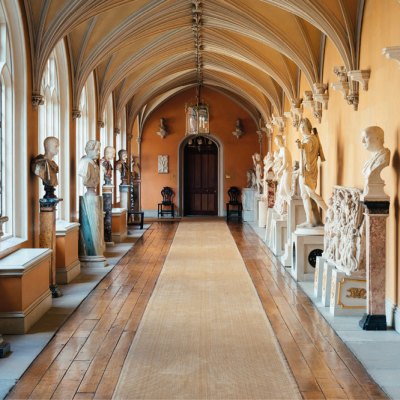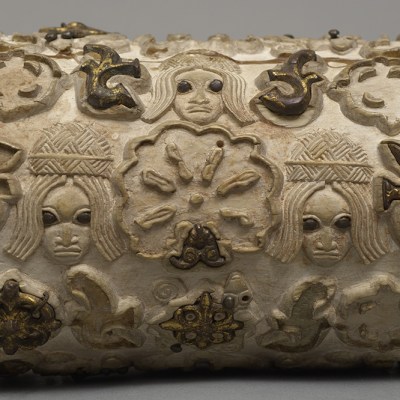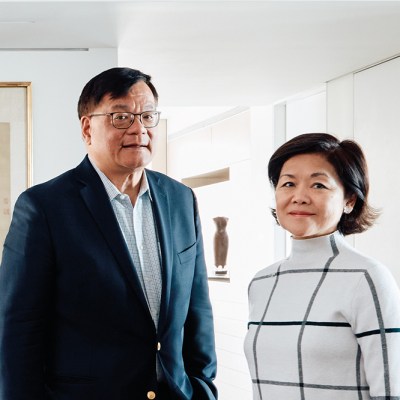From the March 2023 issue of Apollo. Preview and subscribe here.
Top-quality antiquities are scarce and now require such lengthy research into their origins that the leading dealers in them show at few art fairs: TEFAF in Maastricht is one of the exceptions. As a result it is a must-see for antiquities collectors, and a growing number of cross-over collectors of contemporary art.
This year nine antiquities galleries are showing at TEFAF, including Galerie Cahn (Basel), Galerie Kevorkian (Paris) and David Aaron (London), which have histories going back more than a century. But in recent years a new energy has been apparent in the antiquities section, as a younger generation of dealers has emerged. They are creating aesthetically striking presentations highlighting the artistic qualities, not just the historical significance, of the pieces they show and putting provenance to the fore. This is in marked contrast to the past, when dealers had large inventories and collectors would build comprehensive collections without too much thought about how the objects came to be in their possession.
‘Dealing and collecting used to be radically different,’ says Charis Tyndall, who jointly runs the gallery founded in 1971 by Charles Ede. ‘Dealers would show hundreds of objects – shelves and shelves – and anyone could walk in [with things] off the street.’ While dealers paid a lot of attention to authenticity, provenance was less of an issue. ‘People didn’t really have their eyes open to what a lack of provenance might mean,’ Tyndall says. ‘It wasn’t that people were deliberately doing something wrong, it is just that there wasn’t the same level of awareness of the potential problems as there is now.’ Such lack of concern was not just found among antiquities galleries. As recently as 2000 the International Council of Museums UK and the Museums Association began a campaign to stop British museums from acquiring unprovenanced ancient objects.
Torso of an official (c.1700–1550 BC) Egypt. Charles Ede, London, £18,000

Provenance research in antiquities is about more than establishing authenticity, as it is in fine art. If an object does not have a find spot and date, as many antiquities do not (recording these is a modern archaeological practice), research helps establish that it has not been recently excavated, hacked off a monument or stolen from a museum. It also helps to confirm that it has not been taken across borders, in contravention of national laws restricting export of culturally important items, even by a legal owner. Countries that have ancient heritage dating back thousands of years – ‘sources’ such as China and Mediterranean countries – are determined to stop trafficking and in the past few decades have introduced such controls. But antiquities have circulated without question for hundreds of years, from the Romans collecting Greek sculptures to British aristocrats taking a Grand Tour.
Until recently there was little discussion about the provenance of objects in private collections and museums. But campaigns for the return of cultural heritage – perhaps most famously Nigeria’s for the Benin Bronzes – has thrown a spotlight on historic looting. Recent conflicts in countries such as Iraq, Syria and Yemen have raised fears about criminals and terrorist groups exploiting the chaos to smuggle out historic artefacts.
No one knows how big a problem this illicit trade might be, despite an often repeated but unsubstantiated claim by Unesco that it could be $10bn a year. In 2020, a report by the US think tank the Rand Corporation argued that the ‘market for all antiquities, both licit and illicit is […] at most, a few hundred million dollars annually’.
‘It’s impossible to quantify the problem because there is a lack of reliable data. But in the UK investigators see illicit objects all too regularly,’ says Fionnuala Rogers, founder of Canvas Art Law and the chair of the Blue Shield in the UK (a non-governmental organisation that works to put in place protection for cultural property in times of war and natural disaster). ‘But the problem is not, in general, in the established art trade. There is a network of private dealers, individuals and groups, many of whom do not reside in the UK, who sell to uneducated collectors.’
Nevertheless, there remain concerns that illicit objects may have, over the years, found their way into museums and galleries. In January, Ali Aboutaam, co-owner of Phoenix Ancient Art, which has galleries in New York and Geneva, was found guilty by a Swiss court of contravening the law on the transfer of cultural property and ordered to pay legal costs of CHF450,000. The investigation related to a large stock of antiquities he had inherited from his father. In a statement his lawyers blamed ‘the legal imbroglio of national legislation and international treaties and conventions and their entanglement and inconsistency’, with which Aboutaam ‘had not always been able to align himself’. Phoenix Ancient Art, which has been connected with a number of investigations over the years, counts museums in the United States and Middle East among its clients.
In summer 2022, French investigators charged the former president of the Louvre, Jean-Luc Martinez, and curator Jean-François Charnier with ‘complicity’ and ‘having facilitated acquisitions’ by the Louvre Abu Dhabi of allegedly trafficked Eygptian antiquities. The allegations have stunned the Parisian art world: Martinez is France’s official ambassador for international cooperation on cultural heritage issues. The proceedings are continuing.
There is much debate among Western governments about the need for further action. In the United States, a 2022 Treasury report into money-laundering and the financing of terror found that the risk among auction houses and galleries was low and ‘should not be an immediate focus for the imposition of comprehensive anti-money laundering and counter-terrorism funding requirement’.
The European Union has taken a different tack, with new regulations on the import of cultural goods coming into force at the end of 2020. These cover fine and decorative art, antiquities, fossils and other protected natural history specimens, manuscripts and icons. A new system of import licences and a centralised database are not yet operational (the deadline is 2025), and how they will happen is the subject of much controversy. But currently envisaged, this will be the most stringent cultural goods regime in the world, putting the onus on collectors, museums and galleries to prove that any antiquities imported into the EU are not loot, rather than on the authorities to prove that it is.
Any impression that the legitimate antiquities trade is not now scrupulous about provenance, antiquities dealers say, is one they are determined to overturn. ‘Provenance is the number one issue in our field,’ says Costas Paraskevaides, founder of ArtAncient, an antiquities gallery founded in 2008 and now based next to Chelsea Harbour, London. Last year in Maastricht, ArtAncient showed two 5,000-year-old Egyptian stone sphinxes that had been misattributed as 19th-century copies and used as ornaments in a Suffolk garden. ‘All of us do so much research and most dealers now are extremely careful. I’m in my late thirties, so I could still be dealing in 30 years: I don’t want a problem [to come back to haunt me] in the future,’ Paraskevaides says.
He says his clients, many younger and based on the West Coast of America, are not conventional connoisseurs but like to mix up art, antiquities and natural history specimens: ‘They want incredible examples of the very best in different categories.’ They are also wised up, thanks to the Internet, on the questions to ask. ‘They want to see a lot of documentation and third-party expertise.’ ‘When I was studying a decade ago, we learned a lot about the scandals of the 1980s, 1990s and early 2000s,’ Charis Tyndall says. ‘People of my generation ask a lot more questions, and we are much more conscious of what could go wrong.’ They are also much more sensitive to contemporary debates around the restitution of artworks to source countries and the ‘decolonisation’ of museums. ‘We are much better placed to deal with a field that is wonderful and has a lot of depth but where there are changing priorities and fashions now, and where it is easy to seem irrelevant.’
Galleries now devote most of their time to provenance research on a smaller group of more important, higher-value objects with a known history. This much closer scrutiny goes hand-in-hand with a much greater desire by collectors for singular objects, she adds. ‘More and more people are looking for material that is beautiful, something that captures the heart and the imagination. They want a few really standout objects or a small collection displayed in a more contemporary way.’ At TEFAF, Charles Ede’s presentation includes a 3,000-year-old head-and-shoulders sculpture of the Egyptian goddess Hathor, a fragment of a life-size Roman head of a barbarian and a very rare 19cm-high bronze Greek kouros dating to 550–500 BC.
Torso of Hercules, Roman (1st–2nd century AD). Galerie Chenel, Paris, €640,000

The French Galerie Chenel, founded by Ollivier Chenel and his wife Gladys just over 20 years ago, has established a reputation for striking stone sculptural pieces. Last year it presented a huge Roman marble urn with lion handles dating back to the second century AD. This year its stand will include a 2,000-year-old Egyptian polished stone nude. Its provenance dates back to at least 1769 in Rome, and it is believed to have once been displayed at Hadrian’s villa at Tivoli.
‘We like marble, we like stone, we like sculpture and we’ve always been attracted by the support itself,’ Ollivier Chenel says. ‘When we started in the late 1990s, people were look- ing for Attic vases, little bronze sculptures, small things to go in display cabinets. We had a vision of antiquities that was much more fashionable and contemporary. We wanted to show people things you couldn’t only see in sculpture museums but that you could have at home.’ The son of an antiques dealer, he says he wasn’t always as aware of the issues around antiquities as he is today. ‘But because I bought like my father – from reputable auction houses and existing collections in Europe, never from source countries – we applied an early due diligence without really knowing it.’ Salomon Aaron is the fourth generation of his family to be involved in the David Aaron gallery, founded in 1910. As well as specialising in classical Greek and Roman, Egyptian, near Eastern and Islamic works, he and his two brothers have introduced spectacular large-scale dinosaur fossils – another collecting trend. ‘We try to focus on acquiring the best quality, and pay close attention to the supporting provenance documentation across all categories,’ he says. ‘That is making it increasingly clear there are a limited number of objects [we can deal with] on the private market.’
There is little doubt that the established antiquities trade is transforming, even if international legislation is proving divisive. Archaeologists and heritage organisations have applauded the EU’s uncompromising stance. The art world, however, is not alone in questioning the practicality of its implementation. The UK, which was still inside the EU when the new cultural goods regulation was enacted and has left many other EU rules intact, has rapidly revoked it. Either way, there is now a substantial gulf in the desirability and prices for objects with verifiable provenance and those without.
From the March 2023 issue of Apollo. Preview and subscribe here.
Tuesday 7 March: a previous version of this article stated that Ali Aboutaam was fined CHF450,000 by the Swiss court. We have amended this to state that he was ordered to pay legal fees up to the amount CHF450,000.



